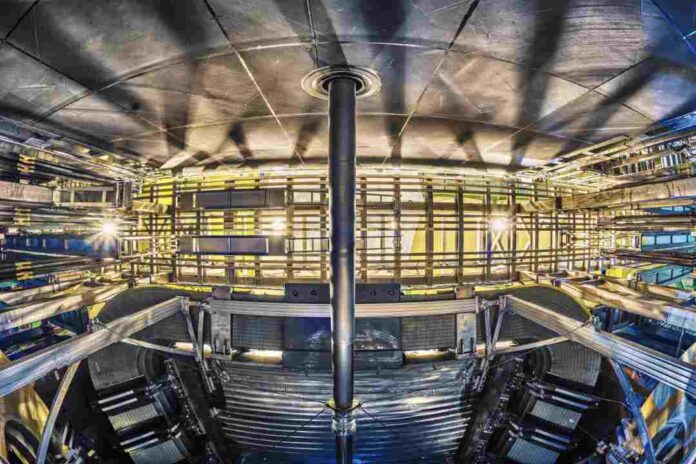Numerous investigations aim to observe enigmatic exotic particles in order to further our understanding of the matter and physics in the cosmos and to open up new areas of inquiry. In 1964, scientists proposed a theoretical model predicting the presence of basic subatomic particles called quarks in a variety of forms.
It is hypothesised that numerous subatomic particles are made up of quarks and antiquarks. Mesons, baryons, and more complicated particles with four or five quarks (i.e. tetraquarks and pentaquarks) all fall under this category.
For over a decade, scientists from all around the globe have been utilising data gathered at CERN’s LHC particle collider in Switzerland to attempt and get a glimpse of these interesting particles in the beauty (LHCb) experiment. Physical Review Letters just released their report on the first direct observation of a doubly charged tetraquark and its neutral companion.
Yasmine Sara Amhis, the physics coordinator of the LHCb experiment, said Phys.org, “In the past decade, the LHCb experiment has done pioneering work in the discovery of so-called exotic particles.” The LHCb identified the first pentaquark in 2015, and this paved the route to many subsequent discoveries. Finding and mapping the characteristics of tetraquarks and pentaquarks, as well as discovering the other particles they decay into and their quantum numbers, is a top priority for LHCb’s study into exotic particles.
There are currently a number of phenomenological theories that attempt to describe tetraquarks and pentaquarks by making predictions about the binding of quarks to generate these particles. The LHCb team may be able to provide light on the validity of these theories by seeing and quantifying the characteristics of these particles.
Researchers have analysed data from the first two experimental runs of the LHC as part of a study. They covered the years 2011 and 2018, inclusive.
An example of one of the most “tough” investigations undertaken by our partnership, the analysis that resulted to this discovery is “extremely complex,” as Amhis put it. The LHCb experiment got its name since b-quarks and their byproducts were the principal focus of early studies. This publication reports the observation of a pair of tetraquarks using a technique called amplitude analysis. This method is based on the interference between particles and their quantum behaviour.
The LHCb collaboration conducted a sophisticated study that may be simplified as a combined analysis with an emphasis on symmetries. In particle physics, symmetries play a significant role in the so-called Standard Model, the guiding theory of particles and the forces that govern them.
Amhis remarked, “Symmetries are also potent since they allow us draw similarities and interactions between particles.” The isospin symmetry connecting the two particles discussed in this work predicts that they have identical masses and widths. As a result, the combined study can detect subtler differences in the characteristics of these particles than any individual investigation of their isospin partners could.
The LHCb collaboration has released over 600 publications detailing their groundbreaking observations of previously undiscovered particles and physical processes. While most of their research reaffirmed the validity of the Standard Model of particle physics, a few of their investigations uncovered novel phenomena.
Papers like this one, Amhis argued, prove that new discoveries, even the unexpected ones, are still conceivable. There have been around 70 new hadronic particle discoveries at the LHC, with the vast majority occurring at LHCb. The strong force, one of the four fundamental forces of existence, is responsible for binding quarks into hadrons, and our comprehension of this force improves as we learn more about the types of hadrons that exist and their characteristics. Having a better grasp of the strong force reduces the theoretical uncertainties involved with searches for physics beyond the Standard Model, so opening up new avenues of investigation.
LHCb’s new findings may soon guide future theoretical and experimental investigations into the physics of tetraquarks. The LHC’s third round of data gathering has commenced, and in the meanwhile, the cooperation has made considerable upgrades to its infrastructure.
In comparison to earlier experimental runs, the LHCb anticipates collecting five times as much data per year during its third phase. They expect this fresh information to lead to exciting new discoveries and insights.
For the study of hadrons in particular, “the upgraded detector is projected to gain another factor of two,” Amhis said.
LHCb can now analyse not only proton collisions but also the collision of protons with a wide range of nuclei thanks to a vastly enhanced technique for feeding gases into the detector chamber. The study of unusual hadron generation in various collision settings provides yet another avenue for progress in this area. Searching for new exotic hadrons, improving our ability to measure the characteristics of existing exotic hadrons, and hunting for both known and new exotic hadrons in a variety of collision settings are all goals for our future work.
Reference:
R. Aaij et al, First Observation of a Doubly Charged Tetraquark and Its Neutral Partner, Physical Review Letters (2023). DOI: 10.1103/PhysRevLett.131.041902
